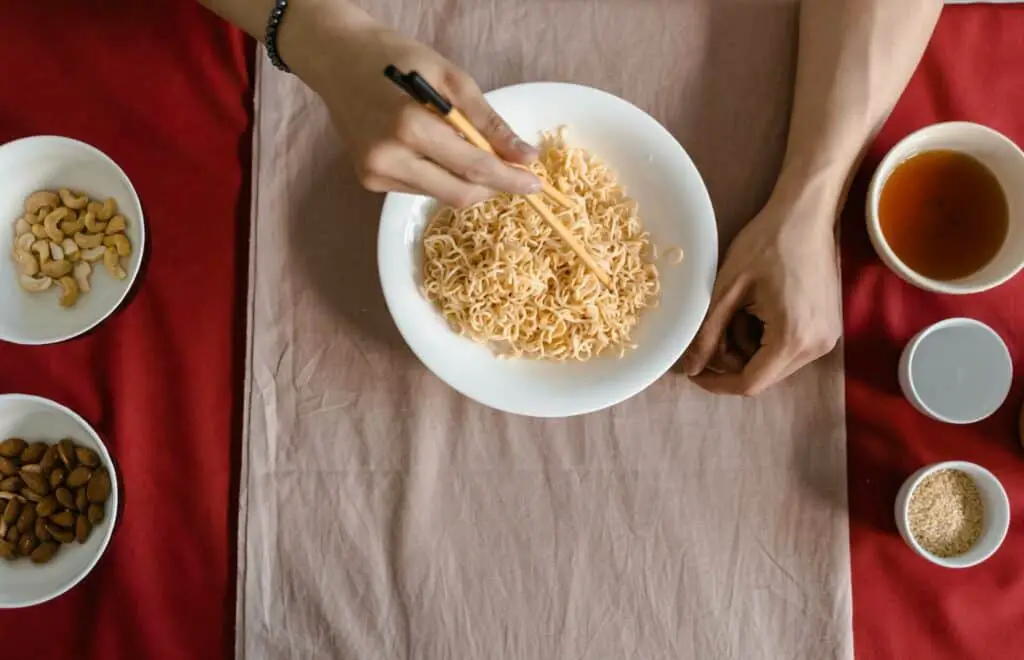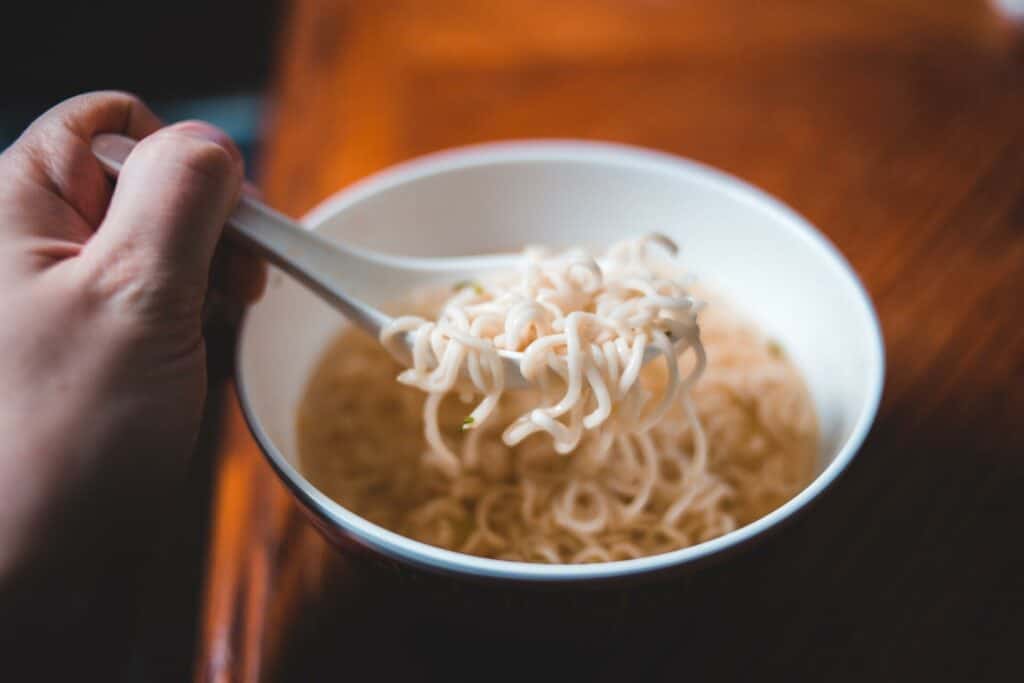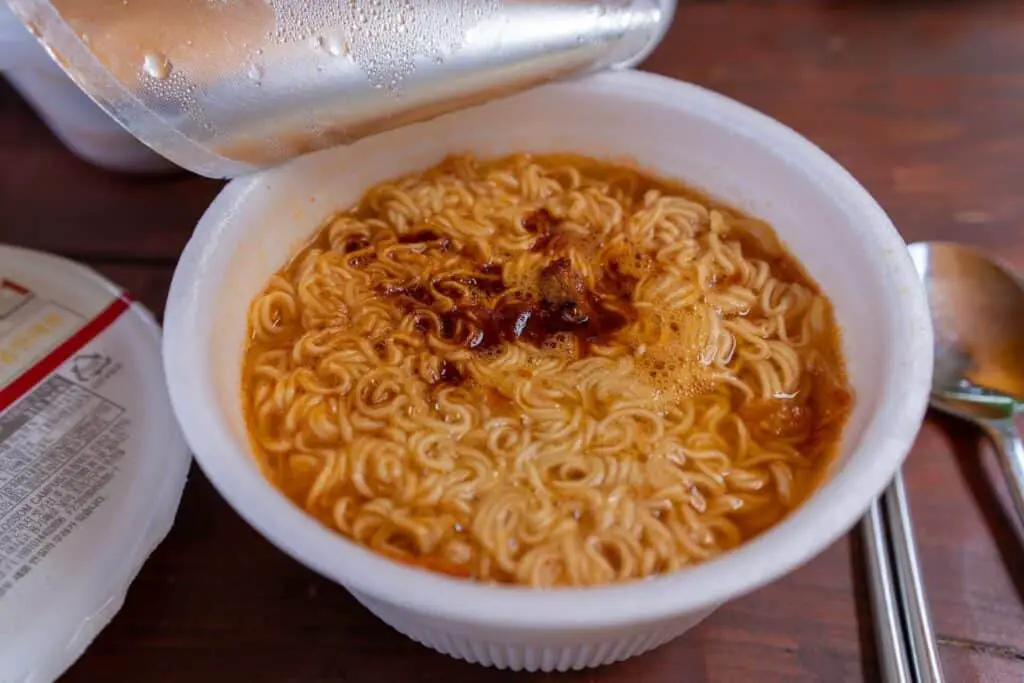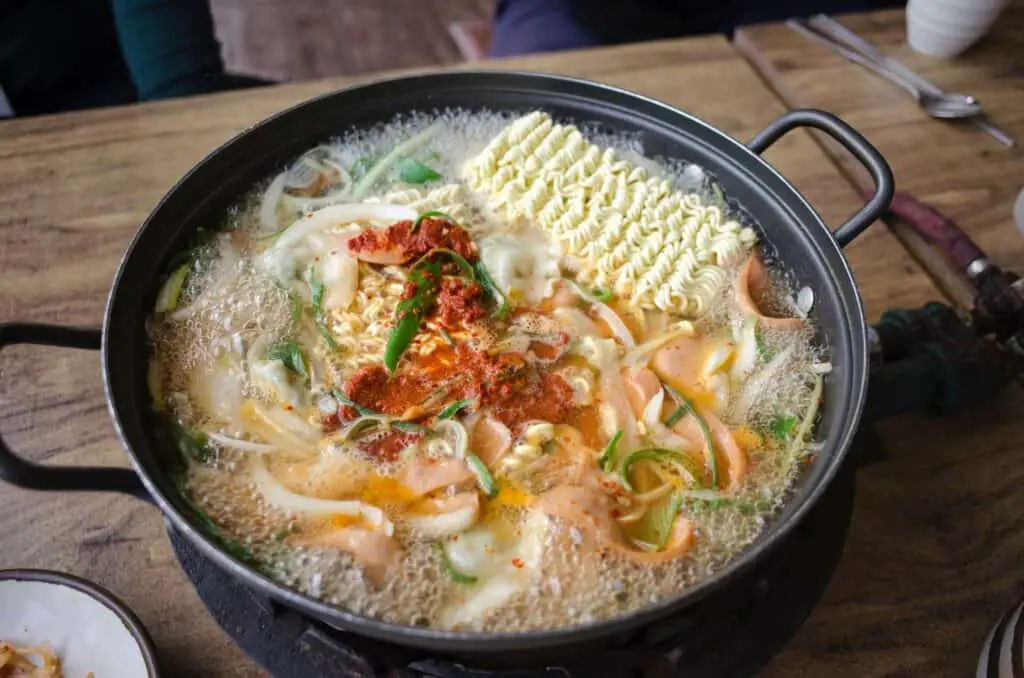Instant Noodles might just be the best food staple since sliced bread. They’re easy to make, tasty on their own, and even tastier with condiments and spices. You can prepare them however you prefer, including in the microwave oven. Here’s how to cook ramen in the microwave in the easiest way possible.
Ramen is easily prepared in microwaves. All you need is your favorite noodle packet, a bowl, some water, and a good microwave to heat it all up. It’s quick and easy; you can do this anywhere with the right equipment and even spice up your plain broth with extra ingredients.
In just four to five easy steps, your instant noodles will go from zero to hero:
- Remove the noodles from the packaging,
- Place them into a bowl and add water,
- Place it all into a microwave oven and cook evenly,
- Make the broth tasty by adding the flavor packet,
- You can also add condiments and veggies to your recipe.
This guide will cover all these steps in detail and help you prepare the ideal noodle dish with extra nutrition and ease.
How to Cook Ramen in Microwave – What You’ll Need
Before preparing your noodle dish, you should get ready for the process. Having all your ingredients at the ready will help things move much faster and smoother, so instead of rushing around to get everything, ensure it’s already by your side.
Here’s what you’ll need to prepare your noodle dish:
- A soup bowl (not too big, and not too small – something to fit all the ingredients),
- A microwave oven,
- Your favorite noodle pack (if you’re unsure of the difference between ramen and noodles, check it out),
- Water (1 to 2 cups at most),
- The seasoning bag from the package,
- Extra condiments and ingredients (this is optional).
The optional seasoning and ingredients are listed in step 5 and can vary depending on your taste. I presented the most common ingredients added to noodles, making the dish more flavorful and appealing.
It’s OK to eat plain ramen with the seasoned broth if you prefer, but there’s something about extra vegetables and seasonings that give it a more elevated look and feel. It’ll be like restaurant food right at home.
Speaking of restaurant food, this Ichiran noodle kit is ideal for bringing classy recipes to your home.
What’s the Best Method for Cooking Instant Noodles?
While microwaving the noodle dish seems to be the easiest method, you must be careful. If your oven doesn’t have heat settings and levels, you could overcook them. If you don’t observe the noodle dish while it cooks, it might get a bit too soggy.
You can also boil water and pour it over the noodles. You can use your kettle, which is likely more accessible to people living in smaller spaces (students especially,) and prepare your meal in roughly the same amount of time.
Below is a simple video for microwaving noodles plainly and without any additional seasonings or flavors. You might find it ideal for your preferences and living conditions.

Step 1 – Remove the Noodles From the Packaging
Step 1 is pretty straightforward – you must remove the noodle pack from the bag before preparing it. The plastic bag that they come in isn’t possible to microwave (unlike the paper bags popcorn comes in,) so the first thing to do is take the noodle brick out.
Some people prefer to prepare the noodle pack without breaking it; they come in a sort of dried brick form, and if you put them in a container whole, they’ll be long and more similar to the real deal.
Others prefer to break the noodle brick into smaller pieces while still in the packaging. This makes them more like a regular soup noodle mix and easier to scoop with a spoon.
I personally prefer to eat them as similar to the authentic Japanese dish as possible, so I don’t break the noodle apart, but some of my family members break them into pieces and eat the dish in the form of a hearty soup.
When you open the package, you’ll see a flavoring pack filled with seasoning that suits your tastes. My favorite is beef-flavored noodle mix, but many folks prefer chicken flavoring.

Step 2 – Place Them Into a Bowl and Add Water
After successfully taking your noodle out of the packaging, place it in a suitably sized bowl. It can be a ceramic or plastic, heat-resistant container if you’re low on fancy dishes. Ensure your plastic container has the symbol that labels it microwave-safe.
The symbol looks like a small oven with three waves on it. Depending on the dish manufacturer, this can also be just a square, but it’ll always have the three wavy lines on it. If your container doesn’t have this symbol, you can risk malfunctioning your oven and melting the damaging substances in the plastic directly into your food.
Now that you have the proper container, place your (broken or whole) noodle pack into it. Put one or two cups of liquid, depending on your preferences. I prefer to pour just a bit over the top of the noodle brick (one cup, approximately) because I don’t want to dilute the seasoning flavor too much.
Another Way Is to Heat up the Water Before Placing the Ramen Into the Microwave
If you want to avoid the soggy noodle texture, you don’t have to prepare everything together. You can also pour a cup of water into the desired container, heat that up, and just splash it over the noodle pack and seasoning.
This is similar to boiling in a kettle, but you’ll be microwaving it instead. The process length is pretty much the same, so if you need a tool replacement in this recipe, you have it.
There isn’t much difference between microwaving just the broth and microwaving it with the noodle pack. The one thing I could list as negative would be overcooking the noodle pack if it stays in for too long or undercooking it if you end the process too quickly.
When it comes to boiling the liquid first, you’ll be able to feel the noodle texture as it cools; but you can always stop your oven’s heating process and check the texture, too. It’s just what’s easier and more convenient for you.

Step 3 – Place It All Into a Microwave Oven and Cook Evenly
If you’re going the route of preparing the noodle pack in a cooker, step 3 will be effortless for you. This is, after all, the most straightforward way to prepare them well. No matter what tip you find, you won’t go wrong with this method.
Once you’ve poured a cup or two of broth into the container with the noodle brick, put it in the cooker for about 3 to 5 minutes, and ensure you check their consistency halfway through.
When two minutes have passed, open the oven and check the temperature and consistency of the noodle. If you’ve placed them without breaking, this is essential for getting the right texture and cooking it all evenly.
Once you’ve taken the container out of the oven, flip the noodle brick and break it apart so it can be done more evenly throughout. Put the container back in, and leave it in for another minute or two, not too long to boil them to the brink of falling apart and not too short that they stay half-raw.
Some folks prefer soggier and softer noodle textures because they prefer to eat it as soup. However, I prefer to make the noodles the main attraction of the dish, so I leave them in for just under two minutes during the second round, so they don’t go too soft.
Don’t Eat as Soon as You Take the Ramen Out of the Cooker
You might be inclined to start eating immediately after microwaving your noodle dish. Leaving the noodle in for too long might just increase the sogginess levels, but they won’t go bad immediately. You can (and should) wait around a minute for the container and its contents to cool down.
If you burn your tongue, you won’t feel anything but pain, which will render the dish pointless in a way. Additionally, don’t take the container out of the oven with your bare hands. This is necessary to point out because some people find themselves brave enough for it.
Why is it essential not totake anything out of the oven with our bare hands? Burns can quickly happen. You could cause damage to the skin of your hands by handling hot containers with your bare hands, so ensure you have a rag or an oven glove ready.
You can either take out the bowl safely and let it sit for a few minutes or leave it in the oven while it cools. That way, you don’t have to scramble for an improvised kitchen glove but use your bare hands instead.

Step 4 – Make the Broth Tasty by Adding the Flavor Packet
Now that you’ve cooked your ramen and taken it out (hopefully with some heat protection on your hands,) it’s time to mix in the flavor packet. It’s a silver bag that came with the noodle pack in the bag, and it’s the flavoring provider.
The store-bought noodle pack without the MSG seasoning pack is just bland, soggy dough that provides only some nutritional value and no flavoring whatsoever. Adding the flavors is an unmissable step.
Open the packet with scissors (since it’s tough to do it with one’s hands – I’ve tried) and pour in the whole thing. If your flavoring comes with chili powder, in that case, your noodle dish might become really spicy.
Even a little bit of this chili powder will be enough to spice things up, but if you enjoy very hot food, adding the whole portion of chili will be your cup of tea. You can always have the dish be less spicy by adding and taking away seasoning.
Mix the entire dish after adding the flavoring, as the powder has to dissolve before consumption. You can eat it from the same container or serve it in a fancier dish.
Does the Flavor Packet Go Before or After Cooking the Noodles?
This is the real question many people ask. There’s no right or wrong way to introduce the flavoring to the dish, as it’ll taste the same pretty much any way it’s made. Still, some folks found that the flavoring comes out better if it’s cooked together with the noodle.
Traditionally, the broth should be brought to a boil in a saucepan, and then the flavoring and the noodle pack are added. Alternatively, you can get the same effect if you pour already boiling liquid onto the noodles and flavoring together.
You can also dissolve the flavoring first and boil the flavored broth in the oven, but there’s a risk of not diluting the seasoning properly. Either put the flavoring after it’s been cooked or pour the boiling liquid over it and the noodle together.

Step 5 – You Can Also Add Condiments and Veggies to Your Recipe
Your noodle dish doesn’t have to be bland and boring. The great thing about store-bought noodle packs is that they’re a sort of blank slate you can decorate and garnish with many things; this can elevate a simple microwavable meal into a fancy-looking, extremely nutritious dish.
Don’t let anyone tell you how to eat your favorite quick noodle dish – you can elevate it and spice it up the way you prefer. There are perfect condiments, seasonings, and even veggies and meats for this meal.
The Best Condiments for Instant Noodle Dishes
You can combine extra seasonings with the already present flavoring pack or take it out of the equation entirely and just make your own seasoning combo. There’s no harm in adding it, as it has a distinct and very nice taste, but combining it with other ingredients will make the meal even tastier. You can even use extra, frozen noodle packs, just thaw them out before cooking.
After removing the noodle container from the cooker, try adding one (or more) of these seasonings or condiments:
- Olive oil,
- Hoisin sauce,
- Miso paste,
- Soy sauce,
- Lime juice,
- Lemon juice,
- Sriracha,
- Gochujang (Korean red pepper chili paste)
- Rice vinegar,
- Parsley,
- Basil,
- Onion powder,
- Garlic powder.
The perfect combination of one, many, or even all of these ingredients can be achieved with balance. I wouldn’t recommend putting all of them in the noodle dish, but I can tell you how I like to season my noodle soup.
I put in Hoisin sauce, a sweet sauce with a soybean paste base, and some extra sugar. It’s incredibly flavorful and gives the broth a more complete taste. Besides Hoisin sauce, I pour a tiny bit of olive oil and onion powder.
The olive oil gives the broth a bit of a fuller flavor; besides being just flavored liquid, there’s a depth with this addition, something hearty and a little more enjoyable. For me, however, the real game-changers are the veggies I put next to my noodle batch.
Sometimes, I like to put in some dairy products, but generally, if you’re lactose intolerant, you shouldn’t. Ensure you check if your ramen has dairy before purchasing it, because some packs come with cheese flavoring.
Vegetables That Go Well With Instant Noodle Dishes
I’m one of those people who don’t just want to boil a broth and pour it over a noodle pack, calling it a day with that. No, for me, the store-bought noodle experience reaches new heights.
I prefer to roughly chop some vegetables and cook them together with my noodle pack in the micro-oven. They get softer that way and give some vegetable stock flavoring to the liquid.
Here’s a list of amazing vegetables you can put into your noodle dish:
- Celery,
- Carrots,
- Peas,
- Sweet corn,
- Spinach,
- Onions,
- Radishes,
- Broccoli,
- Green onions.
When I make my noodle dish, I chop up celery and carrots. It cooks and becomes tender through and through, and then I sprinkle the flavoring, onion powder, and the noodle brick (I don’t break them).
Once it’s cooked, I pour hoisin sauce and oil and top it off with chopped green onions. I added pickled radishes a few times, but that may be an acquired taste for some. Whenever I have broccoli around, I add it to my noodle dish, as it’s one of my favorite vegetables and just makes the entire dish a bit more complete.
There’s something about a quick and effortless noodle dish that can be turned into an elevated dining experience with a few simple steps and ingredients that I really enjoy.
Animal Products You Can Put In Your Noodle Dish
Some folks love to eat their noodle meal with meat and eggs. This makes the dish feel more like actual Japanese ramen, that’s typically garnished with a soft-boiled egg and some well-cooked pork or other meats.
However, before serving any meat with your meal, ensure it’s cooked. It can’t be prepared well in the amount of time it takes to prepare and boil the noodle dish, so it should either be leftover meat from before or cooked just before preparing the noodle mix.
The same goes for the egg. Boiled eggs need to be cooked well before actually garnishing the dish. Some folks use fried eggs, too, but I recommend the boiled egg because it’s easier to eat and a little tastier when it comes to its combination with the noodle texture and flavors.
Just know that you don’t have to wait too long for your meat to be cooked. The heat from the boiling broth will tenderize it a bit more; just ensure that, while searing it, it isn’t raw or inedible. This especially applies to chicken.
Sometimes steak is eaten rare, but that cannot be the case with chicken. Ensure the white meat or chicken thighs you plan to use are fully cooked.
Here are the kinds of meats you can put in your noodle dish:
- Chicken breast,
- Pork tenderloin,
- Flank steak,
- Hot dogs,
- Ham,
- Bacon,
- Beef jerky,
- Duck meat.
Cooking Instant Noodle Packs Is Easy, and You Can Add Whatever You Want
So, to recap – you need your store-bought noodle pack (check how much they cost here,) a microwaving-safe bowl, a cup or two of water, and extra ingredients to spice things up. You must be careful when taking the dish out of the oven because it will heat up and burn you.
Ensure you also pause the process halfway, check on your noodles’ consistency, and stir them, so they get cooked evenly.
If you choose to put in some meat, eggs, seasoning, or vegetables, I’d love to hear more about that combo. It may seem odd to spice things up this way at first, but once you try your quick meal with extra ingredients, you won’t ever go back.
Having good cooking skills just means people can combine flavors well and elevate the simple things in life. You’ll feel like a proper chef when you start using more stuff with your ramen, and the chances of getting more nutrition and healthy calories out of this meal increase tenfold.